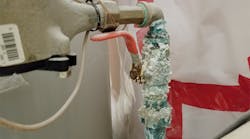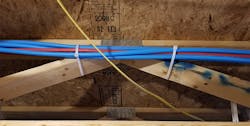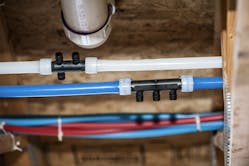I have a friend who is an architect in Fargo, N.D. He has lived in his house for about a decade and has always had plumbing problems, such as low flow from hose bibs and sinks, poor pressure at showers, and long hot-water delivery times. Over time, he grew to accept the poor performance of his plumbing system. But last year he got married, and suddenly he had a strong desire to fix the problems.
Initially when he came to me, I suggested a simple hot-water recirculation line to solve his hot-water delivery problem. After a house visit, I saw that a simple recirculation line was not even possible. Why? He had a homerun system.
Without giving too much away, we were able to fix all of his plumbing issues (for now and into the future). But in order to do so, we had to do a full system re-pipe.
The good and the bad of homerun systems
If you like to sell pipe, homerun systems are wonderful. In fact, my friend’s house had approximately 500 feet of pipe installed for just eight water fixtures. The designs are simple: You basically start at the water service with a manifold, consisting of a larger pipe that has several smaller pipe ports extending from it. Then you bring a dedicated line to each fixture on both the hot and the cold side. The ½-inch PEX (crosslinked polyethylene) lines are small, so installation is simple. And if the supply pressure is adequate, your customers won’t complain.
However, homerun systems are notorious for poor hot-water delivery times. My friend had to wait 26 seconds for hot water at his kitchen sink (the farthest fixture from his water meter). All his other hot-water lines still had cold water in them, though. His next closest fixture clocked in at somewhere around 15 seconds. Hot-water recirculation is not the greatest option for these systems, as they can almost double the amount of hot-water lines in a house.
Poor hot-water delivery wasn’t the only problem
The delivery times shouldn’t have been that bad, though, even with a homerun system. After snooping around, I saw major corrosion and scale on the outside of the metal pipes and near the metal fittings. Also, the pressure from the city was limited, somewhere around 45 pounds per square inch (psi).
They also used insert fittings for the PEX piping system, which basically shrinks water-delivery diameters down to an orifice the size of a drinking straw. Finally, the installation was atrocious. This piping job resembled a bad DIY project.
The fixture terminations looked great, but under the floor, all the hot and cold lines were bundled together without any insulation separating them. Additionally, the sole means of support for the entire system were plastic zip ties. After 10 years, they were so brittle you could practically snap them just by looking at them.
The solution
The only way to fix the flow and pressure issues, provide recirculation, and fix all the corrosion problems was to do a complete system re-pipe. Rather than replace the system with another homerun layout (which wouldn’t be able to recirculate the hot water), we designed a logic system. The latter resembles traditional trunk-and-branch, but instead of individual fittings for the branch lines, it uses multiport tees to connect to the water fixtures. It’s like localized homerun areas off a large distribution line.
In a logic system, hot-water delivery is normally longer than a homerun system for the most demanding fixture on first use. The lines supplying the entire house start large and then reduce as they near the end of the system. There is usually a little larger volume of water to evacuate from the lines. The nice part is, once the hot lines are charged, homeowners only need to wait a couple seconds if they use an adjacent fixture.
After the install, my friend’s wife went from being displeased to being amazed.
The job of the recirculation system is to make sure the main line is already charged with hot water. When the homeowner opens a fixture, it wastes less water with every use, because the hot water is in the line already.
For this project, we decided to design and install a gravity recirculation system because it was more economical than using a pump to recirculate the water. A gravity recirculation system uses the buoyancy of hot water to circulate water through a system naturally.
We pitched a supply line up to the farthest point on the hot-water system. Then, we pitched a dedicated recirculation line from the farthest part of the system back down to the drain on the water heater. Once there, we installed a check valve, a few fittings, and re-piped the drain valve.
As the water in the hot line cools, it sinks back down to this low point on the system, flows through the check valve, and back into the water heater. We insulated all the hot-water lines except for the last 20 feet on the recirculation return line to help the water cool down.
The payoff
By tearing out the entire system, we managed to find all the corroded and scaled-up pipe (some of which you could hardly see any light shining through it). We removed all the metal from the system with the exception of the stop valves at the fixtures.
To ensure the system never corrodes or builds up scale again, we re-piped entirely with PEX. We also removed the existing PEX lines and insert fittings to install larger PEX pipe, sized per the UPC, along with expansion fittings that allow 25 percent greater flow with less pressure drop. Even with a gravity recirculation line, we managed to use around 40 percent less piping.
But how much time, pipe, and water did we really save?
- The new logic system reduced water waste from 1.39 gallons to 0.15 gallons when delivering water to each hot-water fixture.
- The wait time for hot water decreased from 56 seconds to 9 seconds for hot-water delivery on the entire system. The most demanding fixture went from 26 seconds to 3 seconds for hot-water wait time. And finally…
- We reduced the amount of installed pipe from approximately 500 feet on the old homerun system to 270 feet on the new logic system. (It would have only been 220 feet, but we ran an additional 50 feet for the recirculation return line.)
Happy plumbing system, happy life
After the install, my friend’s wife went from being displeased to being amazed. With the smarter logic design, a lot less pipe, a few multiport tees, and some larger-diameter expansion fittings, we were able to make a huge difference in how their plumbing system operates and performs.
If you want to learn more about a logic plumbing system, feel free to contact me at [email protected]. Until then, happy plumbing!
Dan Hubbard is the customer trainer at Uponor Academy. He can be reached at [email protected].




